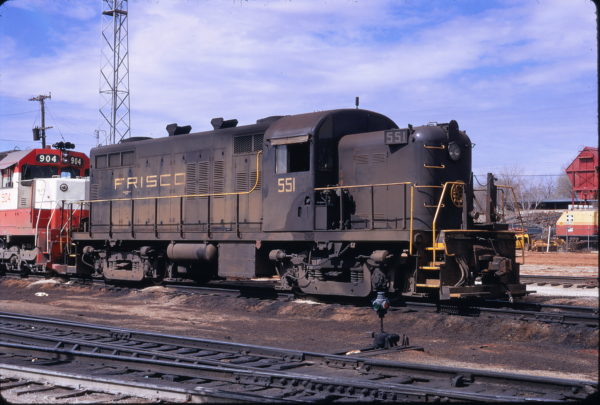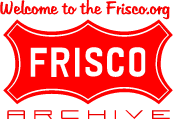
RS-2m 551 at Springfield, Missouri on March 17, 1972.
Share this:
- Click to share on Facebook (Opens in new window)
- Click to share on Twitter (Opens in new window)
- Click to share on Pinterest (Opens in new window)
- Click to share on Pocket (Opens in new window)
- Click to share on LinkedIn (Opens in new window)
- Click to share on Skype (Opens in new window)
- Click to share on Telegram (Opens in new window)
- Click to share on WhatsApp (Opens in new window)
- Click to share on Tumblr (Opens in new window)
- Click to share on Reddit (Opens in new window)
- Click to email this to a friend (Opens in new window)
- Click to print (Opens in new window)

SLSF 551 is unique among its repowered sister RS-2m units (SLSF 550-554). It received a scavenged short hood from a foreign road donor locomotive. During late 1969 or early 1970, the locomotive had rear end short hood damage and deterioration that needed rebuilding. A replacement short hood was purchased from Precision National Corporation (PNC). PNC was a locomotive remanufacturer, short term lessor and salvage company from 1963 – 1997. It traced its roots to 1931 as Precision Engineering Company (PECo) a crankshaft manufacturer.
The replacement hood came from a former Toledo, Peoria and Western (TP&W) Railroad retired RS-2, TPW 204. Of the railroad’s seven RS-2s (TPW 200-206) three, 200, 201 and 203, were retired and used as trade-in credit to EMD in late 1965. The railroad retired TP&W 204 and sold it to PNC on February 24, 1968. When it was retired it was still in the as delivered paint scheme of medium olive green with light yellow striping. Their remaining three units would be painted in that railroad’s later orange with white stripes and lettering paint scheme.
At the Springfield Diesel Shop the Frisco removed the damaged short hood and replaced it with the donor hood. Unlike most production RS-2 units, the TP&W units were built to run with the short hood forward. In contrast, the Frisco’s RS-2 units ran long hood forward. Frisco units had large, high mounted, angled number boards at the peaks of the forward and rear locomotive hood corners. The height of the number boards extended halfway above the top of the hood height. They were angled at 45 degrees to the length of the locomotive.
The TPW units also had large, high mounted, angled number boards. However, in contrast on their units these were set further back on the hood sides, behind the flag and light brackets and electrical connections for class lights. Further they were mounted lower on the hood sides so that their tops did not extend above the hood height. Also, the TP&W number boards were angled at a more shallow 30 degrees to the length of the locomotive.
In addition, the TP&W units had a rounded top flat metal plate on the hood end that extended above the height of the nose and sandbox fill hatch. This originally served as a bracket to high mount a Pyle National Gyralite oscillating warning light. Below the light, but above the standard headlight, the railroad painted the locomotive number. The TP&W style number boards and warning light bracket, sans the Gyralite, remained when the short hood was installed on the Frisco unit.
For a short period Frisco’s RS-2m 551 appeared in black with simplified yellow chevron stripes, but with the rear short hood in TP&W medium olive green with light yellow nose and hood side stripes. After a trip to the Springfield West Shops paint shop the locomotive emerged with an all-black short hood end to match the rest of the unit’s paint. The balance of the unit was not repainted at that time. However, the grab irons and handbrake wheel were painted contrasting yellow, but the short hood end did not receive any yellow chevron stripes or under headlight diamond.
As background, SLSF 551 was shipped from the American Locomotive Company (Alco) to the railroad on 10/14/1949. Dissatisfied with the performance of Alco’s 12-244-B engine, the locomotive was sent to General Motors (GM) Electro Motive Division (EMD) for repowering during November 1959. It received a derated EMD 16-567-C model engine. Derating the engine by 250 horsepower better matched the remaining electrical components of the RS-2 units and balance of the EMD GP7 fleet units. Afterward it and its four sister RS-2m units were treated as any other standard GP7 unit. Due to the taller height of the new power plant and associated equipment, the modified (“m” suffix) unit received a new long hood with single 48” forward and rear radiator fans.
In addition, with different repowering modification dates the new long hoods differed. Repowered in November 1959, SLSF 551, 553 and 554 received long hoods from then in production units with characteristics representing features of a GP9 phase 3c. Units SLSF 550 and 552 were repowered in October 1960. They received long hoods built with then in production characteristics representing features of GP18 phase 1 units. The primary distinguishing feature of the hoods is the car body side radiator grill screens, “chicken wire” for the former and horizontal slat for the latter.
SLSF 551 would be retired and used as trade in credit to EMD in April 1972. At retirement it remained in simplified black and yellow paint. It was the only Frisco RS-2m unit to have both new replacement long and short hoods. Likewise, sister units SLSF 550, 553 and 554 were also retired and traded into EMD in April 1972. SLSF 553 had been retired and used for trade in credit to EMD in December 1969.
The locomotives are sitting on the diesel pocket track east of the Springfield Diesel Shop and northeast of the locomotive service tracks area. The diesel pocket track was used for longer term storage of locomotives awaiting their turn in the diesel shop. Also visible is General Motors (GM) Electro-Motive Division (EMD) SD45 SLSF 904. The diverging tracks in the foreground lead to the locomotive service tracks 3 and 4 of 5. The through route is the lead to the locomotive traction bulk dry sand delivery unloading facility and the 9 tracks on the east side of the diesel shop.
The track beyond the locomotives is the Clinton Subdivision, also known as the High Line. In addition, it serves as the lead to the Springfield West Shops complex and Benwood Yard. Benwood was the primary storage yard for damaged rolling stock headed to the West Shops complex, Bridge and Building (B&B) Department component materials storage yard, the rail reclamation and continuous weld rail (CWR) plant. Adjacent to the yard on the north side was the former Frisco, then American Creosoting and later Kerr-McGee tie creosoting plant.
In the distance on the right edge of the image is a red wood chip storage bin and loader at Ozark Hardwoods Company. The firm was served from a railroad spur track that diverged from the North Main track just west of North Broadway Avenue. Ozark Hardwoods received gondola loads of harvested large diameter hardwood trees. Also on this spur track to the east was Springfield Plywoods, Inc. and Barkley-Love Oil Company. These firms were a plywood distributor and a bulk oil dealer.
Hope this helps.
Thanks!
Mark